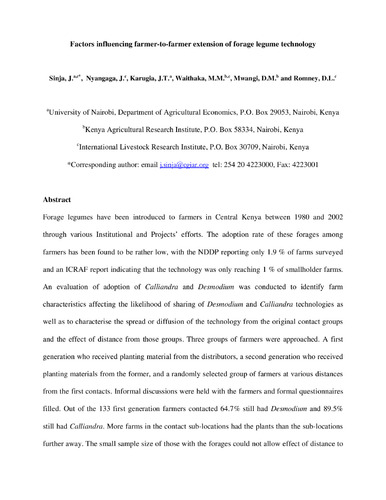Factors influencing farmer-to-farmer extension of forage legume technology
Abstract
Forage legumes have been introduced to farmers in Central Kenya between 1980 and 2002 through various Institutional and Projects’ efforts. The adoption rate of these forages among farmers has been found to be rather low, with the NDDP reporting only 1.9 % of farms surveyed and an ICRAF report indicating that the technology was only reaching 1 % of smallholder farms. An evaluation of adoption of Calliandra and Desmodium was conducted to identify farm characteristics affecting the likelihood of sharing of Desmodium and Calliandra technologies as well as to characterise the spread or diffusion of the technology from the original contact groups and the effect of distance from those groups. Three groups of farmers were approached. A first generation who received planting material from the distributors, a second generation who received planting materials from the former, and a randomly selected group of farmers at various distances from the first contacts. Informal discussions were held with the farmers and formal questionnaires filled. Out of the 133 first generation farmers contacted 64.7% still had Desmodium and 89.5% still had Calliandra. More farms in the contact sub-locations had the plants than the sub-locations further away. The small sample size of those with the forages could not allow effect of distance to be worked out. Tobit estimates of effects of farmer attributes influencing sharing of planting materials shows that the status of the household head in the community positively affected the likelihood of giving out planting material. The technology has a rather slow spread as indicated by percentages of farms with the forages. For better adoption and spread proponents of the technology should have the technology introduced to farmers who have substantial positions in farmer groups or have been bestowed community responsibility.

